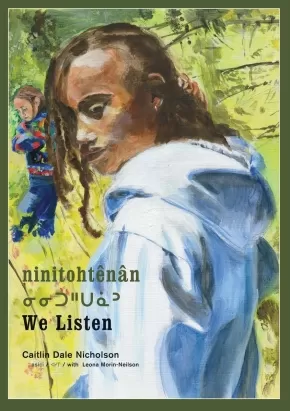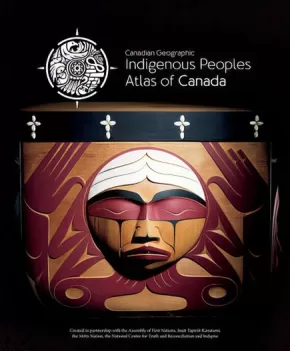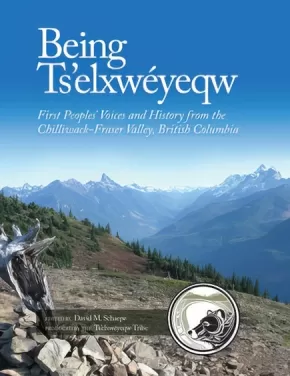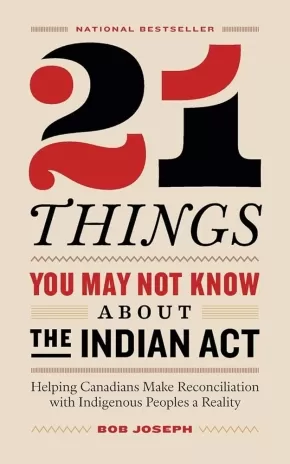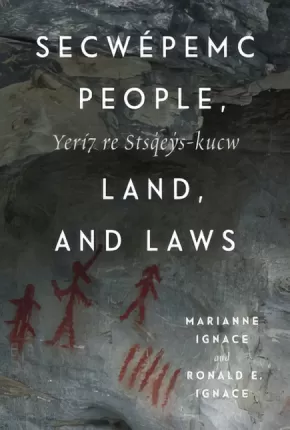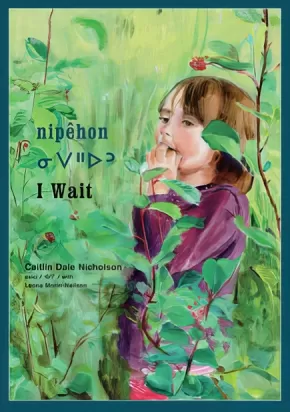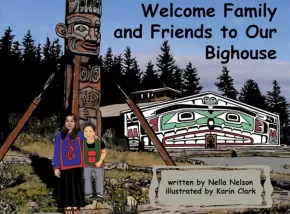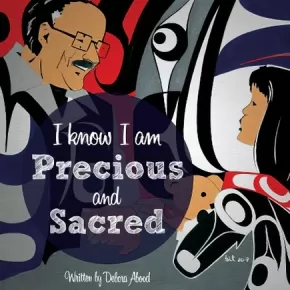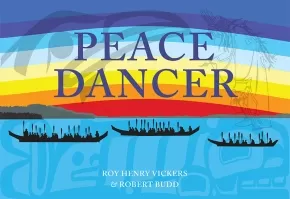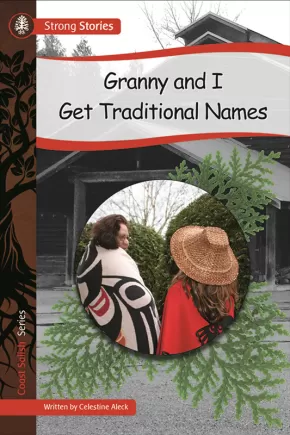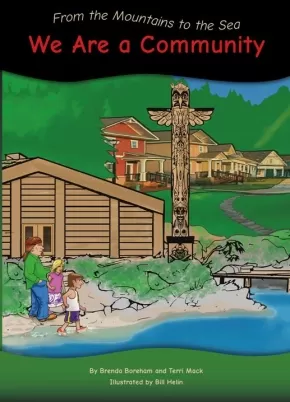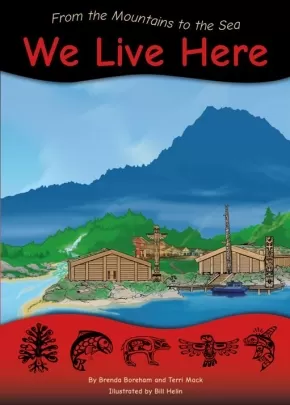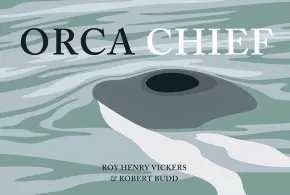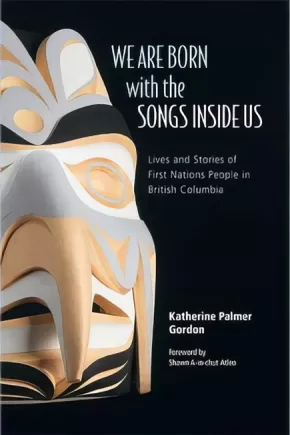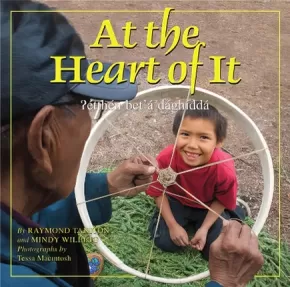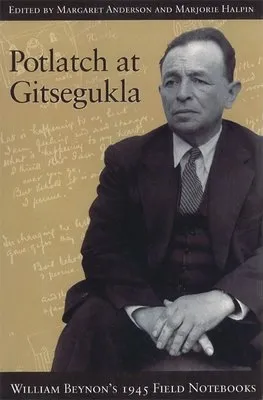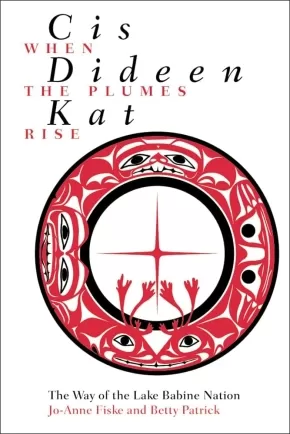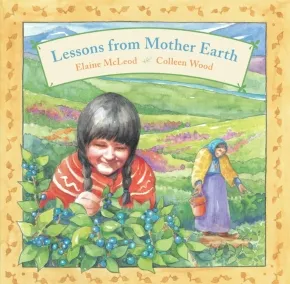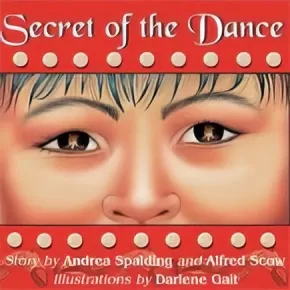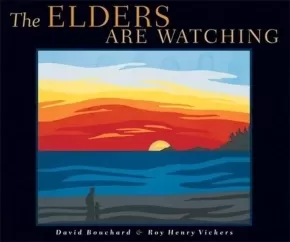
BC First Nations Land, Title, and Governance: Elementary / Secondary (Grades 2 - 12)
1
-
15
of
26 Results;
Sort By
Go To
of 2
ninitohtênân / We Listen
$21.99
Artists:
Format:
Hardcover
Text Content Territories:
Indigenous Canadian; First Nations; Cree (Nehiyawak);
ISBN / Barcode: 9781773068596
Synopsis:
Synopsis:
The third book in the Nôhkom series, in Cree and English, tells a story about gathering leaves for Labrador tea, while listening in different ways.
A child, her family and her friend have arrived at their favorite picnic spot by the lake, but before they eat lunch Nôhkom suggests they pick leaves for Labrador tea. Once among the trees, Nôhkom pauses for a moment to listen, and the others do too. Nôhkom prays, the girls take their turn, then Nôhkom shows them where to find the leaves. Nôhkom and Mom rest after harvesting, but the girls opt for a swim in the lake ... though they're quite happy to warm up afterwards with freshly brewed Labrador tea. And when it's time for the picnic, the girls take another turn at listening.
Beautifully rendered paintings in acrylic on canvas show the family outing. Includes a recipe for Labrador tea as well as a salve made from Labrador Tea leaves.
Educator Information
Recommended Ages: 3 to 7.
Written in short sentences in Cree and English (with Cree text appearing in standard roman orthography and syllabics), the book is a good choice for beginning readers and/or language learners.
This book is the third book in the Nôhkom series.
The story features different forms of listening — in the bush, to teachings from Nôhkom, to the conversation of family and friends (when listening can be especially fun!).
Key Text Features
illustrations
recipe
informational note
Correlates to the Common Core State Standards in English Language Arts:
CCSS.ELA-LITERACY.RL.1.2
Retell stories, including key details, and demonstrate understanding of their central message or lesson.
CCSS.ELA-LITERACY.RL.1.7
Use illustrations and details in a story to describe its characters, setting, or events.
Authenticity Note: Translator Leona Morin-Neilson is the inspiration for the stories and art in the Nôhkom series, which highlights her traditional knowledge of the uses of wild plants. She collaborated with the author to create this work and translated it into Cree.
Because of the collaboration between Leona and the author, and Leona's Cree translation, this book has been labelled as containing Authentic Indigenous Text. It is up to readers to determine if this work is authentic for their purposes.
Additional Information
24 pages | 8.50" x 12.25" | Hardcover
First Nations 101: Tons of Stuff You Need to Know - 2nd Edition
$23.00
Format:
Paperback
Text Content Territories:
Indigenous Canadian; First Nations;
ISBN / Barcode: 978-0-9869640-1-5
Synopsis:
Synopsis:
Updated and expanded 2nd edition of the national best seller!
First Nations 101 provides a broad overview of the day-to-day lives of Indigenous people, traditional Indigenous communities, colonial interventions used in an attempt to assimilate Indigenous people into mainstream society, the impacts those interventions had on Indigenous families and communities, and how Indigenous people are working towards holistic health and wellness today.
This 2nd edition has over 75 chapters, including new ones on rematriation, water for life, governance ‘options’, Indigenous feminisms, decolonization, (mis)appropriation, Indigenous Knowledge, and how to become a great ally.
Educator Information
Author Lynda Gray’s accessible writing style makes First Nations 101 the perfect primer for all to read. She notes that although governments may encourage and fund reconciliation activities, true reconciliation can only happen through the ongoing commitment and consistent actions of individuals, groups, organizations, governments, and businesses.
$1 from each book sold will be donated to the Ts’msyen Revolution Fund which Lynda Gray and her children, Dr. Robin Gray and artist Phil Gray, started in 2022. The Fund will help support Ts’msyen language and culture revitalization in laxyuubm Ts’msyen (Ts’msyen territory).
Lynda Gray is member of the Ts’msyen Nation from Lax Kw’alaams on the Northwest Coast of B.C. The book’s cover art was created by her son Phil Gray and features a 'neełx (killerwhale) to represent the author and her children’s clan (Gisbutwada).
The 2nd edition has over 75 chapters, with 16 new ones including rematriation, what is reconciliation, traditional economies, water for life, Indigenous feminisms, (mis)appropriation, economic development, Indigenous Knowledge, how to become a great ally, and more.
Additional Information
336 Pages | Updated and expanded 2nd edition
Indigenous Relations: Insights, Tips & Suggestions to Make Reconciliation a Reality
$19.95
Format:
Paperback
Text Content Territories:
Indigenous Canadian; First Nations; Inuit; Métis;
ISBN / Barcode: 9781989025642
Synopsis:
Synopsis:
Indigenous Relations: Your Guide to Working Effectively with First Nations, Métis, and Inuit.
A timely sequel to the bestselling 21 Things You May Not Know About the Indian Act - and an invaluable guide for anyone seeking to work more effectively with Indigenous Peoples.
We are all treaty people. But what are the everyday impacts of treaties, and how can we effectively work toward reconciliation if we're worried our words and actions will unintentionally cause harm?
Hereditary chief and leading Indigenous relations trainer Bob Joseph is your guide to respecting cultural differences and improving your personal relationships and business interactions with Indigenous Peoples. Practical and inclusive, Indigenous Relations interprets the difference between hereditary and elected leadership, and why it matters; explains the intricacies of Aboriginal Rights and Title, and the treaty process; and demonstrates the lasting impact of the Indian Act, including the barriers that Indigenous communities face and the truth behind common myths and stereotypes perpetuated since Confederation.
Indigenous Relations equips you with the necessary knowledge to respectfully avoid missteps in your work and daily life, and offers an eight-part process to help business and government work more effectively with Indigenous Peoples - benefitting workplace culture as well as the bottom line. Indigenous Relations is an invaluable tool for anyone who wants to improve their cultural competency and undo the legacy of the Indian Act.
Educator Information
Recommended in the Canadian Indigenous Books for Schools 2020/2021 resource list for grades 11 and 12 in these areas: Social Studies, Law, English Language Arts, and Social Justice.
Additional Information
200 pages | 8.00" x 5.00"
Indigenous Peoples Atlas of Canada
$99.99
Format:
Hardcover
Text Content Territories:
Indigenous Canadian; Métis; Inuit; First Nations;
ISBN / Barcode: 9780986751622
Synopsis:
Synopsis:
Indigenous perspectives much older than the nation itself shared through maps, artwork, history and culture.
The Royal Canadian Geographical Society, in partnership with Canada's national Indigenous organizations, has created a groundbreaking four-volume atlas that shares the experiences, perspectives, and histories of First Nations, Inuit and Métis peoples. It's an ambitious and unprecedented project inspired by the Truth and Reconciliation Commission's Calls to Action. Exploring themes of language, demographics, economy, environment and culture, with in-depth coverage of treaties and residential schools, these are stories of Canada's Indigenous Peoples, told in detailed maps and rich narratives.
This extraordinary project offers Canada a step on the path toward understanding.
The volumes contain more than 48 pages of reference maps, content from more than 50 Indigenous writers; hundreds of historical and contemporary photographs and a glossary of Indigenous terms, timelines, map of Indigenous languages, and frequently asked questions. All packaged together in a beautifully designed protective slipcase.
Educator Information
Recommended for ages 13+.
The Indigenous Peoples Atlas of Canada includes a four volume print atlas, an online atlas, an app, and more!
Additional Information
322 pages | 10.50" x 12.87"
Being Ts'elxwéyeqw: First Peoples' Voices and History from the Chilliwack-Fraser Valley, British Columbia
$94.95
Editors:
Format:
Hardcover
Text Content Territories:
Indigenous Canadian; First Nations; Salish; Coast Salish; Sto:lo; Ts'elxweyeqw;
ISBN / Barcode: 9781550178180
Synopsis:
Synopsis:
“Our stories identify for us the land which surrounds us and tie us to our ancestors. We find ourselves inextricably linked to the past, to the land, to the river, to each other, to the future.” —Shirley Hardman, contributor
This impressive volume tells of the First Peoples of the area through vivid narratives from the past and present.
The traditional territory of the Ts’elxwéyeqw First Peoples covers over 95,000 hectares of land in Southwestern BC. It extends throughout the central Fraser Valley, encompassing the entire Chilliwack River Valley (including Chilliwack Lake, Chilliwack River, Cultus Lake and areas, and parts of the Chilliwack municipal areas). In addition to being an area of natural beauty and abundant resources, it also has a rich cultural history. The Chilliwack region gets its name from the Ts’elxwéyeqw tribe, and this volume delves into what this name means—and also what it means to be Ts’elxwéyeqw. Being Ts’elxwéyeqw portrays the people, artifacts and landscapes that are central to the Ts’elxwéyeqw people, and represents a rich oral record of an aboriginal heritage that has been kept alive—even through adversity—for thousands of years.
Lavishly illustrated with over seven hundred historic and current photos and maps, this book amalgamates a variety of voices and personal histories from elders, while providing background into eighty-five place names within the region. The book’s unique composition—with an emphasis on visual storytelling—showcases a culture with a deep connection to the surrounding land and the watershed.
Educator Information
Recommended for Grades 5-12 for the following subject areas: Geography, Social Studies, Science. Also a useful Teacher Resource.
Note: Educators should pre-read sections of this book that they are considering using from this reference book, as reading levels vary greatly.
Additional Information
304 pages | 11.00" x 14.00"
21 Things You May Not Know About the Indian Act
$21.00
Format:
Paperback
Text Content Territories:
Indigenous Canadian;
ISBN / Barcode: 9780995266520
Synopsis:
Synopsis:
Based on a viral article, 21 Things You May Not Know About the Indian Act is the essential guide to understanding the legal document and its repercussion on generations of Indigenous Peoples, written by a leading cultural sensitivity trainer.
Since its creation in 1876, the Indian Act has shaped, controlled, and constrained the lives and opportunities of Indigenous Peoples, and is at the root of many enduring stereotypes. Bob Joseph’s book comes at a key time in the reconciliation process, when awareness from both Indigenous and non-Indigenous communities is at a crescendo. Joseph explains how Indigenous Peoples can step out from under the Indian Act and return to self-government, self-determination, and self-reliance—and why doing so would result in a better country for every Canadian. He dissects the complex issues around truth and reconciliation, and clearly demonstrates why learning about the Indian Act’s cruel, enduring legacy is essential for the country to move toward true reconciliation.
Reviews
"Increasing Canadians' knowledge about the terrible foundation this country has been built on is a critical part of reconciliation. Bob Joseph has highlighted some of the unbelievable provisions of the Indian Act and how they have impacted First Nations in Canada and gives a brief overview of what we may replace it with going forward. His book provides helpful context to the dialogue that needs to take place in Canada." — Kim Baird, O.C., O. B. C.; Owner, Kim Baird Strategic Consulting; Member of the Tsawwassen First Nation; Negotiator of the Tsawwassen First Nation Treaty
"From declaring cultural ceremonies illegal, to prohibiting pool hall owners from granting Indigenous people entrance, from forbidding the speaking of Indigenous languages, to the devastating policy that created residential schools, Bob Joseph reveals the hold this paternalistic act, with its roots in the 1800s, still has on the lives of Indigenous people in Canada in the 21st century. This straightforward book is an invaluable resource. There is much for non-Indigenous people to learn and to do. But equally important, there is much to unlearn and to undo. The time is right for this book. Thank you, Bob Joseph. Gilakasla." — Shelagh Rogers, O.C.; Truth and Reconciliation Commission of Canada Honourary Witness
"Bob’s ability to navigate the complex history of the Indian Act is a wonder to behold. He provides depth and knowledge for Indigenous and non-Indigenous scholars alike. Whether you are an Indigenous scholar or a neophyte, his articulate, insightful and comprehensive analysis on the history of the Indian Act provides a sound understanding on the present narrative of Indigenous peoples in Canada. By way of the Indian Act, this book provides an excellent analysis of the ongoing relationship and predicament between provincial and federal governments and Indigenous peoples in the 21st century." — JP Gladu, President and CEO of the Canadian Council for Aboriginal Business
Educator Information
Recommended in the Canadian Indigenous Books for Schools 2019-2020 resource list as being useful for grades 4-12 and as a teacher resource in these subject areas: English Language Arts and Social Studies.
Additional Information
160 pages | 5.22" x 8.05"
Secwepemc People, Land, and Laws: Yeri7 re Stsq'ey's-kucw
$49.95
Format:
Hardcover
Text Content Territories:
Indigenous Canadian; First Nations; Salish; Interior Salish; Secwepemc (Shuswap);
Grade Levels: University/College;
ISBN / Barcode: 9780773551305
Synopsis:
Synopsis:
Secwépemc People, Land, and Laws is a journey through the 10,000-year history of the Interior Plateau nation in British Columbia. Told through the lens of past and present Indigenous storytellers, this volume detail how a homeland has shaped Secwépemc existence while the Secwépemc have in turn shaped their homeland. Marianne Ignace and Ronald Ignace, with contributions from ethnobotanist Nancy Turner, archaeologist Mike Rousseau, and geographer Ken Favrholdt, compellingly weave together Secwépemc narratives about ancestors’ deeds. They demonstrate how these stories are the manifestation of Indigenous laws (stsq'ey') for social and moral conduct among humans and all sentient beings on the land, and for social and political relations within the nation and with outsiders. Breathing new life into stories about past transformations, the authors place these narratives in dialogue with written historical sources and knowledge from archaeology, ethnography, linguistics, earth science, and ethnobiology. In addition to a wealth of detail about Secwépemc land stewardship, the social and political order, and spiritual concepts and relations embedded in the Indigenous language, the book shows how between the mid-1800s and 1920s the Secwépemc people resisted devastating oppression and the theft of their land, and fought to retain political autonomy while tenaciously maintaining a connection with their homeland, ancestors, and laws. An exemplary work in collaboration, Secwépemc People, Land, and Laws points to the ways in which Indigenous laws and traditions can guide present and future social and political process among the Secwépemc and with settler society.
A Day With Yayah
$21.95
Artists:
Format:
Hardcover
Text Content Territories:
Indigenous Canadian; First Nations; Salish; Interior Salish; Nlaka'pamux (Thompson);
ISBN / Barcode: 9781926890098
Synopsis:
Synopsis:
Set in the Okanagon, BC, a First Nations family goes on an outing to forage for herbs and mushrooms. Grandmother passes down her knowledge of plant life to her young grandchildren.
Reviews
"A Day With Yayah is a story sharing the special relationship that is built when a child learns from their Elders. It centers around an Indigenous family out on the land picking herbs and the Grandmother passing down her knowledge." - The Dalai Lama Center
Educator Information
Recommended for grades K-2 for the following subjects: Art Education, English Language Arts, Social Studies.
This resource offers a glimpse into the Nłeʔkepmx of the Nicola Valley in BC's Interior. A glossary of Nłeʔkepmxcin words appears at the back of the book.
Additional Information
32 pages | 9.25" x 10.25" | colour illustrations
Kisimi Taimaippaktut Angirrarijarani / Only in My Hometown
$18.95
Artists:
Format:
Hardcover
Text Content Territories:
Indigenous Canadian; Inuit;
ISBN / Barcode: 9781554988839
Synopsis:
Synopsis:
The northern lights shine, women gather to eat raw caribou meat and everyone could be family in this ode to small-town life in Nunavut, written in English and Inuktitut.
Sisters Angnakuluk Friesen and Ippiksaut Friesen collaborate on this story about what it’s like to grow up in an Inuit community in Nunavut. Every line about the hometown in this book will have readers thinking about what makes their own hometowns unique. With strong social studies curriculum connections, Kisimi Taimaippaktut Angirrarijarani / ᑭᓯᒥ ᑕᐃᒪᐃᑉᐸᒃᑐᑦ ᐊᖏᕐᕋᕆᔭᕋᓂ / Only in My Hometown introduces young readers to life in the Canadian North, as well as the Inuit language and culture.
Angnakuluk’s simple text, translated into Inuktitut and written out in syllabics and transliterated roman characters, is complemented by Ippiksaut’s warm paintings of their shared hometown.
Educator Information
Recommended Ages: 3-7.
Recommended for Grades K-2.
Curriculum Connections: Health & Daily Living, Language Arts, Social Studies.
Additional Information
24 pages | 11.00" x 8.25"
nipehon / I Wait
$18.95
Artists:
Format:
Hardcover
Text Content Territories:
Indigenous Canadian; First Nations; Cree (Nehiyawak);
ISBN / Barcode: 9781554989140
Synopsis:
Synopsis:
A young child, her grandmother and mother are going out to pick wild yarrow. As Grandmother gets ready, the child and her mom wait. Grandmother leads the way to the field of blossoms, where they can finally start to pick … only now they have to wait for Mom!
The simple story, written in Cree and English and accompanied by rich acrylic illustrations, shows the patience, love and humor involved as three generations accommodate one another on a family outing. nipêhon / ᓂᐯᐦᐅᐣ / I Wait was translated by Leona Morin-Neilson, who was the inspiration for the book.
This companion volume to niwîcihâw / I Help includes a recipe for yarrow tea, known for its refreshing and soothing effects.
Educator Information
Recommended Ages: 4-7
This book is written in Cree (the Y dialect) and English. The Cree language is represented in two forms -- standard roman orthography and syllabics.
This book is part of the Nôhkom series.
Recommended for Grades K-1 for the following subject areas: English Language Arts, Indigenous Language Studies, Social Studies, Science and Nature, Visual Arts.
Authenticity Note: Leona Morin-Neilson (Métis-Cree) is a Cree teacher and the inspiration behind this book. She collaborated with the author to create this work. Leona Morin-Neilson teaches Cree at the “Power of Friendship” Aboriginial Headstart program in Prince George, British Columbia, and at the University of Northern British Columbia. She also teaches people in her community about traditional plants and how they can be used for medicinal purposes.
Because of the collaboration between Leona and the author, and Leona's Cree translation, this book has been labeled as containing Authentic Indigenous Text. It is up to readers to determine if this work is authentic for their purposes.
Additional Information
24 pages | 8.50" x 12.25"
Welcome Family and Friends to Our Bighouse
$21.95
Artists:
Format:
Paperback
Text Content Territories:
Indigenous Canadian; First Nations; Kwakwaka'wakw (Kwakiutl);
ISBN / Barcode: 9780973676990
Synopsis:
Synopsis:
This contemporary story is told through the voice of a 12-year-old Kwakwaka’wakw girl named Gana, who lives in ‘Yalis (Alert Bay, BC). From the time she is little, Gana attends Potlatches and ceremonies in the Bighouse. The regalia she wears—a button blanket, dancing apron and masks—were designed and made for her based on her family origins or clans. The ancient cultural teachings she learns in the Bighouse are useful to Gana in her everyday life and continue to have value in the 21st century.
• Full colour illustrations showing aboriginal masks and regalia in context
• Contains some Kwak’wala words with meaning and pronunciation guides
• 11” x 8.5” soft cover, 96 pages
Nella Cook Nelson, originally from the N’amgis Nation, was born and raised in Alert Bay, B.C. It wasn’t until Nella was in grade 4 that integration occurred and aboriginal students were allowed to attend the public schools. When she was 12-years-old, the first Bighouse since the anti-potlatch law had been lifted was built in Alert Bay.
Nella attended both Camosun College and the University of Victoria. When she started teaching in public schools in 1979, aboriginal content didn’t exist. After 11 years teaching, she has coordinated the Victoria School District’s Aboriginal Nations Education Division for 27 years. She serves on Provincial, college, university, community boards and advisory committees to improve aboriginal health, safety and education.
Nella has recieved the Queen’s 125 Commemorative Medal, YM/YWCA Women of Distinction, Camosun’s Distinguished Alumni, and Excellence in Cultural Heritage & Diversity Awards.
I Know I Am Precious and Sacred
$12.00
Format:
Paperback
Text Content Territories:
Indigenous Canadian;
ISBN / Barcode: 9780992151645
Synopsis:
Synopsis:
I Know I Am Precious and Sacred follows a conversation between a child and loving grandfather as they talk about what the words “precious” and “sacred” mean. These culturally integral concepts are explained in simple, practical terms, so that Little Ones may recognize how they affect relationships in families and communities. Readers and listeners are invited to explore how these ancestral teachings impact their families and communities.
I Know I Am Precious And Sacred is a soft-cover children’s book, geared towards readers and listeners ages 5 to 10 years old, but holds out important truths for their adults as well.
Educator & Series Information
This is the second book in the Precious and Sacred series.
Reading level: K-3.
Additional Information
32 pages | 8.00" x 8.00"
Authenticity Note: This book has received an Authentic Text label because it was written by Debora Abood with the support and participation of Elders from the Victoria Native Friendship Centre.
Peace Dancer
$19.95
Text Content Territories:
Indigenous Canadian; First Nations; Tsimshian (Ts'msysen);
ISBN / Barcode: 9781550177398
Synopsis:
Synopsis:
The children of the Tsimshian village of Kitkatla love to play at being hunters, eager for their turn to join the grown-ups. But when they capture and mistreat a crow, the Chief of the Heavens, angered at their disrespect, brings down a powerful storm.
The rain floods the Earth and villagers have no choice but to abandon their homes and flee to their canoes. As the seas rise, the villagers tie themselves to the top of Anchor Mountain, where they pray for days on end and promise to teach their children to value all life. The storm stops and the waters recede. From that point on, the villagers appoint a chief to perform the Peace Dance at every potlatch and, with it, pass on the story of the flood and the importance of respect.
With eighteen new illustrations from Roy Henry Vickers and exceptional narrative, Peace Dancer will delight readers of all ages and add to the collection of global flood stories.
Reviews
"Parents and teachers will enjoy sharing Peace Dancer with children. Highly recommended." — Dr. Gregory Bryan, CM Magazine, October 2016
Educator & Series Information
This book is part of the Northwest Coast Legends series.
This book is part of the Northwest Coast Legends series.
Other books in this series include:
Raven Brings the Light
Cloudwalker
Orca Chief
Peace Dancer
Raven Brings the Light
Cloudwalker
Orca Chief
Peace Dancer
Recommended for ages 3 to 6.
Additional Information
40 pages | 12.00" x 8.25"
Strong Stories Coast Salish: Granny and I Get Traditional Names
 $9.95
$9.95

Format:
Paperback
Text Content Territories:
Indigenous American; Native American; Salish; Coast Salish; Indigenous Canadian; First Nations; Salish; Coast Salish;
ISBN / Barcode: 9781771741279
Synopsis:
Synopsis:
In this Coast Salish story, told in the voice of a young girl, she describes how she and her Granny get ready for their naming ceremony. When the special day arrives, the Longhouse fills with people who will witness and celebrate the sharing of their traditional names.
Educator & Series Information
This book is part of the Strong Stories: Coast Salish series. Strong Stories focus on different First Nation territories from across Canada and the United States. These stories reflect the belief that our stories are the roots of our people, our lands and our cultures. It is from our stories that we grow and become strong and proud.
This resource is also available in French: Grand-maman et moi recevons des noms traditionnels.
Additional Information
16 pages | 6.00" x 9.00" | ISBN: 9781771741279
From the Mountains to the Sea: We Are a Community
 $29.95
$29.95

Artists:
Format:
Paperback
Text Content Territories:
Indigenous Canadian;
Grade Levels: 2;
ISBN / Barcode: 9781771741033
Synopsis:
Synopsis:
Each book in the series, From the Mountains to the Sea, supports the new BC Aboriginal Learning Standards in both Science and Social Studies.
Click link to download a Grade 2 five-week planning guide: Grade 2 FREE Download for We Are a Community
Back of book introduction:
From the Mountains to the Sea: We Are a Community is a Grade 2 resource, which covers all of your Aboriginal Learning Standards in both science and social studies within the new BC curriculum.
This book is about a river. Most rivers start high up in the mountains. As the water comes downhill, it makes little pathways in the rocks and gravel. As the pathways get bigger, they join to make streams. When several streams join, they make a river. Some rivers have waterfalls and deep pools. In some places, fast moving water tumbles over rocks forming rapids. When a river leaves the mountain for flatter ground it starts to slow down. Eventually, a river ends when it flows into the sea. Where the fresh water and the salt water meet is an estuary. Have you ever been to an estuary?
The area in and around an estuary is a good place for plants, animals and people to live because we can all find food and water there. The salmon is an important food for many of us. Have you ever eaten salmon?
People have paid attention to the life cycle of salmon for thousands of years. We have learned that sometimes we can help salmon survive by building a salmon hatchery along a river. Some hatcheries are huge while others are quite small. Have you ever visited a salmon hatchery?
There are many sizes of rivers in the world. Some are wide. Some are narrow. Some are deep. Some are shallow. Do you live near a river? What plants and animals have you seen there?
This book is also part of a bundled package that includes:
- a card game: matching and sequencing
- a CD
- bulletin board trimmers
Click here to view the bundle: From the Mountains to the Sea: We Are a Community Bundle
This resource is available in French: Collection Des montagnes à la mer: Nous sommes une communauté
Additional Information
Book dimensions: 10" x 14" | Pages: 16 | ISBN: 9781771741033
From the Mountains to the Sea: We Live Here
 $29.95
$29.95

Artists:
Format:
Paperback
Text Content Territories:
Indigenous Canadian;
Grade Levels: Kindergarten;
ISBN / Barcode: 9781771741019
Synopsis:
Synopsis:
Each book in the series, From the Mountains to the Sea, supports the new BC Aboriginal Learning Standards in both Science and Social Studies.
From the Mountains to the Sea: We Live Here is a Kindergarten resource, which covers all of your Aboriginal Learning Standards in both science and social studies within the new BC curriculum.
Click link to download a five-week Kindergarten planning guide: Kindergarten FREE Download for We Live Here
Back of book introduction:
This book is about a river. Can you find a river on the front cover of this book? What do you know about rivers?
Most rivers start high up in the mountains. As the water comes down the hill, it makes little pathways in the rocks and gravel. As the pathways get bigger, they join to make streams. Sometimes the streams join together to make a river. Where a river leaves the mountains the ground flattens out, and the river slows down. The river ends when it flows into the sea.
The area in and around a river is a good place for plants, animals and people to live because we can all find food and water there. The salmon is an important food for many of us.
Some of the plants and animals that you will find in this book are:
- Cedar trees live and grow all the way along a river, from the mountains to the sea.
- Salmon spend their adult lives out in the open sea. When it is time to lay their eggs, they swim back to their home streams. Their home streams are sometimes very close to the mountains.
- Bears walk long distances to find their food. They live from the mountains to the sea. In the fall they go to the rivers to fish for salmon.
- Eagles fly over large areas looking for food. They live from the mountains to the sea. In the fall, they go to the rivers to feast on salmon.
- Orcas live in the open sea. They swim long distances to hunt for food. Some orcas eat salmon.
This book is also part of a bundled package: From the Mountains to the Sea: We Live Here Bundle
This resource is available in French: Collection Des montagnes à la mer: Nous habitons ici
Additional Information
Book dimensions: 10" x 14" | Pages: 16 | ISBN: 9781771741019
Orca Chief
$19.95
Format:
Hardcover
Text Content Territories:
Indigenous Canadian; First Nations; Tsimshian (Ts'msysen);
ISBN / Barcode: 9781550176933
Synopsis:
Synopsis:
Thousands of years ago in the village of Kitkatla, four hunters leave home in the spring to harvest seaweed and sockeye. When they arrive at their fishing grounds, exhaustion makes them lazy and they throw their anchor overboard without care for the damage it might do to marine life or the sea floor.
When Orca Chief discovers what the hunters have done, he sends his most powerful orca warriors to bring the men and their boat to his house. The men beg forgiveness for their ignorance and lack of respect, and Orca Chief compassionately sends them out with his pod to show them how to sustainably harvest the ocean’s resources.
Accompanied by almost exclusively new illustrations by Roy Henry Vickers, this next installment of the Northwest Coast Legends will captivate readers young and old with its vivid imagery and remarkable storytelling.
Educator & Series Information
Orca Chief is the third in a series of Northwest Coast legends by Roy Henry Vickers and Robert Budd.
Other books in this series include:
Raven Brings the Light
Cloudwalker
Orca Chief
Peace Dancer
Recommended for ages 3 to 6.
Additional Information
40 pages | 12.00" x 8.25"
Written as I Remember It: Teachings from the Life of a Sliammon Elder
$39.95
Format:
Paperback
Text Content Territories:
Indigenous Canadian; First Nations; Salish; Coast Salish; Tla'amin (Sliammon);
ISBN / Barcode: 9780774827119
Synopsis:
Synopsis:
Long before vacationers discovered British Columbia's Sunshine Coast, the Sliammon, a Coast Salish people, called the region home. Elsie Paul is one of the last surviving mother-tongue speakers of the Sliammon language. In this remarkable book, she collaborates with her granddaughter, Harmony Johnson, and a scholar, Paige Raibmon, to tell her life story and the history of her people, in her own words and storytelling style. Raised by her grandparents who took her on their seasonal travels, Paul spent most of her childhood learning Sliammon ways, teachings, and stories. She shares this traditional knowledge with future generations in Written as I Remember It.
Educator Information
Recommended in the Canadian Indigenous Books for Schools 2019-2020 resource list as being useful for grades K-12 for the following subject areas: English Language Arts, Science, Social Studies, Teacher Resource.
We Are Born with the Songs Inside Us: Lives and Stories of First Nations People in British Columbia
$29.95
Format:
Paperback
Text Content Territories:
Indigenous Canadian; First Nations;
ISBN / Barcode: 9781550176186
Synopsis:
Synopsis:
First Nations are the fastest growing population in the country. There are thousands upon thousands of young First Nations people growing up today who, together with the kind of individuals whose stories are told in this book, represent a future for this country that is brighter than it has been for a long, long time.--from the foreword by Shawn A-in-chut Atleo, National Chief of the Assembly of First Nations
Since 2004, journalist Katherine Palmer Gordon has interviewed dozens of young First Nations people living in British Columbia--artists and community leaders, comedians and consultants, musicians and lawyers, people who are household names and those known only within their own communities. We Are Born with the Songs Inside Us collects sixteen candid stories gleaned from those interviews, stories of people who share an unshakeable belief in the importance of their cultural heritage to their well-being, to their success at what they do, and to their everyday lives.
Included are Kim Baird, former chief of the Tsawwassen First Nation; Lisa Webster-Gibson, spoken word artist and rock-and-roll drummer with Delaware-Mohawk and Scottish-Canadian heritage who lives and works on Gabriola Island as an Environmental Assessment Professional; and John Marston (Qap'u'luq), an artist and storyteller from the Chemainus First Nation who learned to carve from his father. "What I put into each piece," he says, in his interview with Gordon, "is 100 percent me."
Shattering stereotypes, We Are Born with the Songs Inside Us gathers the thoughts and hopes of young native people living in twenty-first century Canada. Each has a compelling, meaningful story that deserves to be told, understood and, above all, celebrated.
Authenticity Note: The author of this book is not Indigenous; however, those who contributed the stories for the book are Indigenous. It is up to readers to determine if this will work as an authentic text for their purposes.
Strong Readers Set B: Planning the Feast (L17)
 $9.00
$9.00

Artists:
Format:
Paperback
Grade Levels: 2;
ISBN / Barcode: 9781771740388
Synopsis:
Synopsis:
Level 17 Illustrated by Bill Helin. Back cover book introduction: Soon there will be a big summer feast at Pine Forest. Raven is ready with lots of plans. What are some of the things that might need to be done before the summer feast? Do you predict Raven will be a good planner?
Educator & Series Information
Planning the Feast is part of the Strong Readers: Set B series. Set B is a continuation of Set A. The mixture of fiction and non-fiction books, from levels 11 through 20, expands on frog, bear, eagle, and raven, considering their full lifecycles.
The Strong Readers are a guided/leveled reading series chock full of science, numeracy, social responsibility, language arts and oral language teachings. Strong Readers are rich with scaffolded text features and have beautiful illustrations and photographs. The entire series is interconnected and follows the cultural values of frog, bear, eagle and raven throughout.
Guided Reading Level: 17
This resource is also available in French: Planifier le festin.
Additional Information
Book Dimensions: 6in x 9in | Pages: 16 | ISBN: 9781771740388
At the Heart of It: Dene dzó t’áré
$19.95
Format:
Hardcover
Text Content Territories:
Indigenous Canadian; First Nations; Dene; North Slavey (Sahtu);
ISBN / Barcode: 9781897252697
Synopsis:
Synopsis:
Raymond Taniton is Sahtugot'ine, which means "people from the Sahtu or Great Bear Lake." He lives in Deline, Northwest Territories, on the shore of Sahtu, Canada's largest and most pristine lake. Raymond, former chief, is one of his community's many gifted leaders.
In At the Heart of It, the seventh book in The Land is Our Storybook series, Raymond shows readers how to make a traditional Dene drum with the help of his father, Alfred, who is a leader and the "keeper of the drum." Raymond shares the importance of keeping traditions alive to maintaining a healthy community. He also introduces readers to Dene spiritual, political, and traditional leaders and explains why Deline is a leader in the NWT in terms of healthy places, people, and land. Sahtugot'ine have never given up their right and responsibility to look after and govern themselves. Join Raymond and find out what is at the heart of the rich history of the Sahtugot'ine.
Educator & Series Information
This book is part of the "The Land Is Our Storybook" series, which considers the diverse lands and cultures of Canada's Northwest Territories. Told in a uniquely diverse range of northern voices, with a child-centred approach, books in the series highlight each official Aboriginal language group in the NWT, revealing a richly textured picture of life in the North-on the trapline, around the campfire, in communities, at school, and within the outdoor school that is the land itself. The series celebrates the seasons, ages, genders, traditional activities, and communities of the NWT.
The stories are illustrated by the striking images of acclaimed northern photographer, Tessa Macintosh and depict the similarities in lifestyle between children of the North and South, as well as the marked cultural differences, and highlight the special relationship these First Nations people have with the land and how they are adapting to rapid change while remaining connected to the land. Images of the landscape and animals within it, of trapping, hunting, fishing, and bannock baking sit alongside pictures of children at school, swimming at recreation centres, and reading in libraries. Here is modern northern culture painted beautifully: a complex mix of the new and the old.
These wonderful books, written with a variety of provincial and territorial curricula in mind, are specially designed for the classroom and include special features such as glossaries relating details on animals biology and cultural definitions, regional and language maps. The text of the stories also have sidebars such as Our Stories, which contain the stories of the people and language group featured, and Our Words, which highlight words in the featured language that are important to the story.
Additional Information
|
Potlatch at Gitsegukla: William Beynon's 1945 Field Notebooks
$39.95
Editors:
Format:
Paperback
Text Content Territories:
Indigenous Canadian; First Nations; Gitxsan (Gitksan); Tsimshian (Ts'msysen);
Grade Levels: 12; University/College;
ISBN / Barcode: 9780774807449
Synopsis:
Synopsis:
William Beynon was born in 1888 in Victoria to a Welsh father and a Tsimshian mother. He was an accomplished ethnographer and had a long career documenting the traditions of the Tsimshian, Nisga'a, and Gitksan. In 1945 he attended and actively participated in five days of potlatches and totem pole raisings at Gitksan village of Gitsegukla. There he compiled four notebooks containing detailed and often verbatim information about the events he witnessed. For over 50 years these notebooks have seen limited circulation among specialists, who have long recognized them as the most perceptive and complete account of potlatching ever recorded.
In Potlatch at Gitsegukla the almost 200 pages of the notebooks are published for the first time. Sketches and a selection of photographs taken by Beynon are also included (augmented by photographs taken by Wilson Duff in 1952). In addition to meticulously transcribing and annotating the text of the notebooks, Margaret Anderson and Marjorie Halpin provide a comprehensive introduction that puts Beynon's account into a Gitskan cultural perspective, as well as extensive appendices listing names, places, and Gitskan terms in the notebooks. There is also an excellent timeline of key events in Gitskan history by James McDonald and Jennifer Joseph.
William Beynon's notebooks are among the most significant written records of Northwest coast potlatching and are an unsurpassed resource documenting these activities among the Gitskan. This rare, first-hand, ethnographic account of a potlatch reveals the wonderful complexities of the events that took place in Gitsegukla in 1945.
Additional Information
296 pages | 6.00" x 9.00" | Paperback
Cis Dideen Kat (When the Plumes Rise): The Way of the Lake Babine Nation (3 in Stock)
$32.95
Format:
Paperback
Text Content Territories:
Indigenous Canadian; First Nations; Nat'oot'en (Lake Babine);
Grade Levels: 12; University/College;
ISBN / Barcode: 9780774808125
Synopsis:
Synopsis:
The heart of the traditional legal order of the Lake Babine Nation of north-central British Columbia is the grand ceremonial feast known as the balhats, or potlatch. Misunderstood and widely condemned as a wasteful display of pride, the balhats ceremonies were outlawed by the Canadian government in the late nineteenth century. Throughout the years that followed, the Lake Babine Nation struggled to adapt their laws to a changing society while maintaining their cultural identity.
Although the widespread feasting and exchange practices of the balhats have attracted continuous academic and political interest since the nineteenth century, little consideration has been given to understanding the legal practices embedded within the ceremonies. Cis dideen kat, the only book ever written about the Lake Babine Nation, describes the customary legal practices that constitute "the way."
Authors Jo-Anne Fiske and Betty Patrick use historical and contemporary data to create a background against which the changing relations between the Lake Babine Nation and the Canadian state are displayed and defined, leading to the current era of treaty negotiations and Aboriginal self-government.
Through interviews with community chiefs and elders, oral histories, focus groups, and archival research, Fiske and Patrick have documented and defined a traditional legal system still very much misunderstood. Their findings include material not previously published, making this book essential reading for those involved in treaty negotiations as well as for those with an interest in Aboriginal and state relations generally.
Cis dideen kat was shortlisted for the 2001-2002 Harold Adams Innis Prize.
Lessons From Mother Earth
$10.99
Artists:
Format:
Paperback
Text Content Territories:
Indigenous Canadian; First Nations; Tutchone; Northern Tutchone; Na-Cho Nyak Dun;
ISBN / Barcode: 9780888998323
Synopsis:
Synopsis:
This gentle story demonstrates the First Nations' tradition of taking care of Mother Earth.
Tess has visited her grandmother many times without really being aware of the garden. But today when they step out the door, Tess learns that all of nature can be a garden. And if you take care of the plants that are growing, if you learn about them - understanding when they flower, when they give fruit, and when to leave them alone - you will always find something to nourish you.
At the end of the day, Tess is grateful to Mother Earth for having such a lovely garden, and she is thankful for having such a wise grandma.
Elaine McLeod's poetic text and Colleen Wood's gentle watercolors combine to make Lessons from Mother Earth a celebration of nature and life.
Educator Information
Curriculum Connections: Social Studies, Science and Nature.
Additional Information
24 pages | 8.80" x 8.80"
Secret of the Dance
$12.95
Artists:
Format:
Paperback
Text Content Territories:
Indigenous Canadian; First Nations; Kwakwaka'wakw (Kwakiutl); Kwicksutaineuk ;
ISBN / Barcode: 9781554691296
Synopsis:
Synopsis:
"Many years ago, when the world and I were younger, my family defied the government."
A boy will never forget witnessing a forbidden Potlatch. In 1935, a nine-year-old boy's family held a forbidden Potlatch in faraway Kingcome Inlet. Watl'kina slipped from his bed to bear witness. In the Big House masked figures danced by firelight to the beat of the drum. And there, he saw a figure he knew. Aboriginal elder Alfred Scow and award-winning author Andrea Spalding collaborate to tell the story, to tell the secret of the dance.
Educator Information
"This story tells of a time when potlatches, ceremonial dancing and the wearing of regalia and masks were forbidden by Canadian law. A young boy, based on Judge Alfred Scow's boyhood story, witnesses the last secret potlatch of this community before the threat of imprisonment caused them to stop dancing." - FNESC, "BC First Nations Land, Title, and Governance"
Additional Information
32 pages | 9.00" x 9.00"
The Elders Are Watching (2 in Stock)
$21.95
Format:
Hardcover
Text Content Territories:
Indigenous Canadian;
ISBN / Barcode: 9781551926414
Synopsis:
Synopsis:
When award-winning writer David Bouchard first saw the work of First Nations artist Roy Henry Vickers, he was struck by Vickers' reverence for nature and his understanding of Canada's rugged West Coast. They collaborated on The Elders Are Watching, which-now in its fifth printing-has delighted more than 100,000 readers in four languages. The artwork in this new edition has been restored to match the vibrancy of the originals.
The boy looked much the same as the other kids in his class. New faces arrived almost daily from far away places, so it wasn't his appearance that made him different.
He had always tried his hardest, but try as he might, somehow he didn't seem to be able to get excited about the same things his classmates did. This year would be no different.
And so, as in years gone by, his mother would please him greatly by taking him out of school for a time. Again, she was sending him to live with his grandfather, his 'Ya-A' - to listen, to think and to learn.
'Ya-A' would reintroduce him to the Wind, the Tree and the Earth. 'Ya-A' would speak of responsibilities and of rights. 'Ya-A' would fascinate him with legends of the eagle, the whale, the raven and the wolf.
Of all the tales his grandfather told, none captured his heart more than the stories of the Old Ones - the Elders. And as the stories slowly became a part of him, by the seashore in the clear red sky of early evening, he began to see them.
They appeared as images suspended in the air, up toward the sun. Their lips were still, yet he heard them speak. Their message, like the words of his "Ya-A', was clear and true, a message gone too long without being passed to other hearts.
He and his "Ya-A' would share the words of the Elders often with all those who cared to listen - with all those who cared at all. ...taken from The Elders Are Watching.
Additional Information
56 pages | 10.94" x 9.06" | Hardcover
Sort By
Go To
of 2

